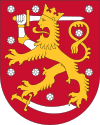Prime Minister of Finland: Difference between revisions
Malekhanif (talk | contribs) No edit summary |
number of cabinets is 61, not 86 |
||
| Line 28: | Line 28: | ||
In 1918, the [[Senate of Finland|Finnish Senate]] was transformed into the [[Cabinet of Finland|Council of State]] (or [[Cabinet (government)|cabinet]]) of Finland, and the position of ''Vice-Chairman of the Economic Division of the Senate'' was transformed into that of a [[Prime Minister]]. [[Kesäranta]] (in [[Swedish language|Swedish]] Villa Bjälbo), located in the [[Meilahti]] area of [[Helsinki]], has been the official residence of the Prime Minister of Finland since 1919. |
In 1918, the [[Senate of Finland|Finnish Senate]] was transformed into the [[Cabinet of Finland|Council of State]] (or [[Cabinet (government)|cabinet]]) of Finland, and the position of ''Vice-Chairman of the Economic Division of the Senate'' was transformed into that of a [[Prime Minister]]. [[Kesäranta]] (in [[Swedish language|Swedish]] Villa Bjälbo), located in the [[Meilahti]] area of [[Helsinki]], has been the official residence of the Prime Minister of Finland since 1919. |
||
Since its independence (declared on 6 December 1917), Finland has had |
Since its independence (declared on 6 December 1917), Finland has had 61 cabinets, the longest lasting being the two cabinets of Prime Minister [[Paavo Lipponen]], both lasting 1,464 days. |
||
== List of Prime Ministers == |
== List of Prime Ministers == |
||
Revision as of 14:13, 13 June 2010
| Prime Minister of the Republic of Finland | |
|---|---|
 Seal of the Government of Finland | |
since 24 June 2003 | |
| Residence | Kesäranta |
| Appointer | President of Finland |
| Term length | Duration of parliamentary convocation, coalition or upon resignation and removal |
| Inaugural holder | Pehr Evind Svinhufvud |
| Formation | 6 December 1917 |
| Website | official website |
 |
|---|
The Prime Minister (Finnish: pääministeri, Swedish: statsminister) is the Head of Government of Finland. The Prime Minister is appointed by the President, who is the Head of State. The current Prime Minister is Matti Vanhanen of the Centre Party.
Overview
Under the provisions of the new Constitution of Finland (enacted in 2000), the President nominates a Prime Minister after the parties in the Eduskunta (Parliament) have negotiated the distribution of seats in the new Council of State and the government's programme. Parliament must ratify the nominated Prime Minister with an absolute majority in a vote without other candidates. If the nominee doesn't receive sufficient support, then a new round of negotiations and a second nomination by the President follows. If the second nominee also fails to gain an absolute majority, then a third vote occurs, in which any member of Parliament can nominate a candidate; in this round a plurality is sufficient for election. The President's formal appointment follows Parliament's election.
The above procedure was first used to elect Anneli Jäätteenmäki to the Prime Ministership in 2003. Previously it was assumed that the President would nominate the candidate who in a third round of voting would have gained a relative majority, usually the leader of the largest party. Before the new Constitution came into force, full formal powers to appoint the Prime Minister and the rest of the Council of State had been the privilege of the President, who was free to diverge from parliamentary principles, although ministers appointed had to have the confidence of the Parliament.
The Prime Minister nominates the remaining members of the Council of State, who are then, with the consent of Parliament, appointed by the President.
In 1918, the Finnish Senate was transformed into the Council of State (or cabinet) of Finland, and the position of Vice-Chairman of the Economic Division of the Senate was transformed into that of a Prime Minister. Kesäranta (in Swedish Villa Bjälbo), located in the Meilahti area of Helsinki, has been the official residence of the Prime Minister of Finland since 1919.
Since its independence (declared on 6 December 1917), Finland has had 61 cabinets, the longest lasting being the two cabinets of Prime Minister Paavo Lipponen, both lasting 1,464 days.
List of Prime Ministers
Interim Prime Ministers
| Period | Interim Prime Minister | Born-died | Party | Note |
|---|---|---|---|---|
| 11 September 1981 – 19 February 1982 | Eino Uusitalo | 1924- | Centre Party | Substitute to Mauno Koivisto, who became President of Finland |
| 3 July 1961 – 14 July 1961 | Eemil Luukka | 1892-1970 | Agrarian League | |
| 9 March 1946 – 26 March 1946 | Carl Enckell | 1876-1959 | none | Substitute to Juho Kusti Paasikivi, who became President of Finland |
| 27 March 1940 – 4 January 1941 | Rudolf Waldén | 1878-1946 | none | Substitute to Risto Ryti, who became President of Finland |
| 17 February 1937 – 12 March 1937 | Rudolf Holsti | 1881-1945 | National Progressive Party | Substitute to Kyösti Kallio, who became President of Finland |
| 18 February 1931 – 21 March 1931 | Juho Vennola | 1872-1938 | National Progressive Party | Substitute to Svinhufvud, who became President of Finland |



